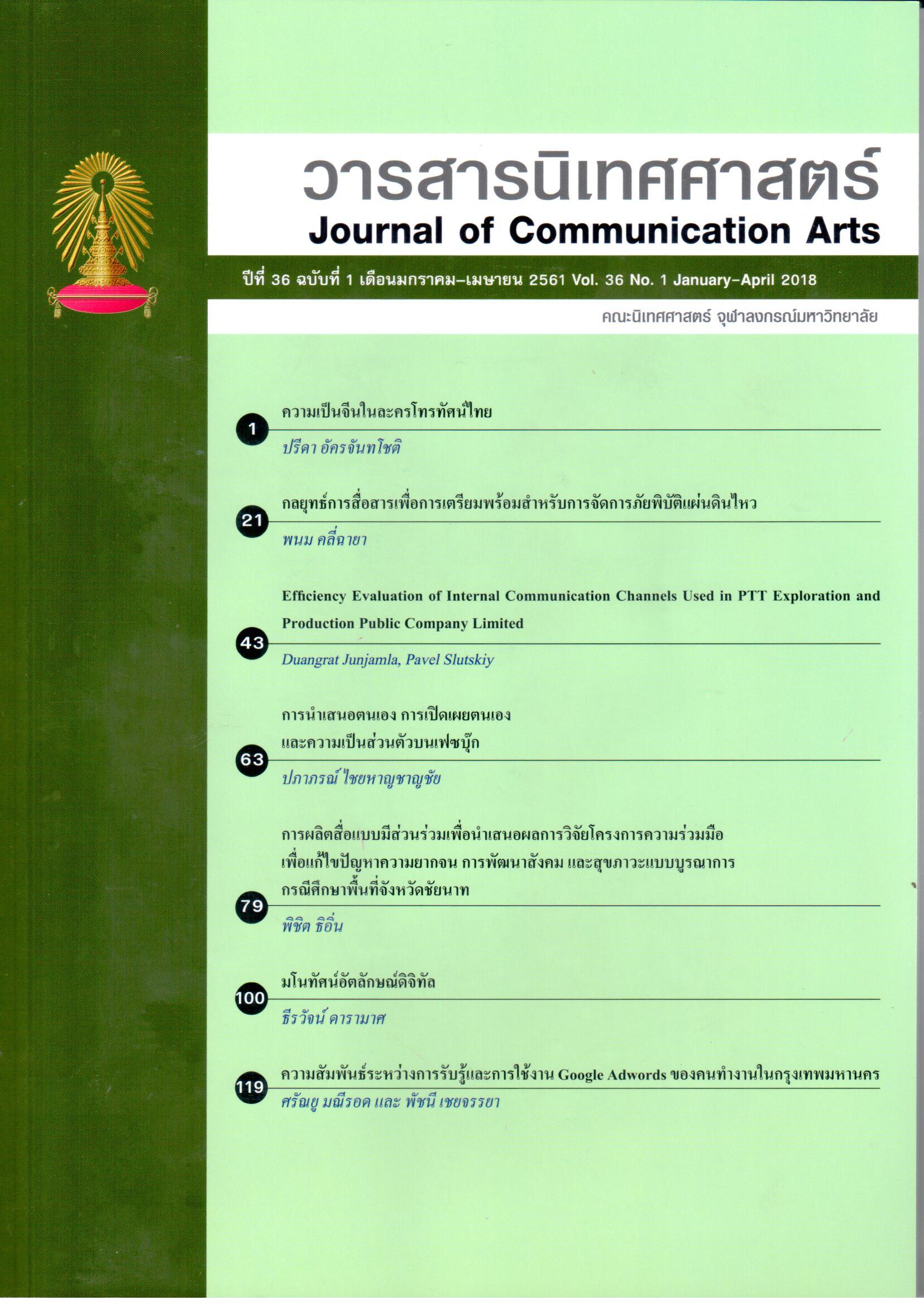Participatory Media Productions for Tacking Poverty, Social Development and Health Integrated: A Case Study of Chainat
Main Article Content
Abstract
The objectives of this research study were 1) to present and to utilize the research results in Chainat of the Thailand Research Fund (TRF) about solving the problems on poverty, social development and integrated health. With the production and dissemination in participatory approach of Chainats and Chandrakasem Rajabhat University students. 2) to know the pattern and level of participation including, the output of the participated production and dissemination for solving the problems on poverty, social development and integrated health in Chainat by research results of TRF. And 3) to improve a learning process on research in communications and development communications, to extend understanding both of Chainats and students also, to cultivate their values on conducting a research study. This study is the Participatory Action Research (PAR).
The research finding was the presentation and utility of the TRF research results about solving the problems on poverty, social development and integrated health in Chainat. These showed the pattern of development communication, based on the research results that focused mainly on participation approach. The applied of participatory on this research was emphasized on every processes of media production; planning, production and dissemination. Besides, the participation showed the cooperation of all stakeholders such as government section, academic section and civil society. The proportion and component in multi-pattern and multi-level of participation of this action research was the success in the Chainat development. The research outcome was edutainment media entitled “Pa Sang Lui” program (Daddy said “Go ahead”). It was a series of 5 episodes for 30 minutes each. The content of each episode consisted of 5 main topics, viz. household accounting, family and generation gap happiness, useful youth hobbies, safe vegetables and community enterprises. The social medias; Facebook YouTube and Line were using as the communication channel. Youths was defined as the target of this media production. Finally, the outcome of this study acquired the participatory process which was valuable to the community leaders, academicians, erudite folks, children and youths in Chainat. Moreover, the program was an outcome of amateur researchers to add values and sustainability to the media by means of being community media, promoting learning of the community dwellers about media production and dissemination. In addition, it was a way to return research findings back to the community and to make tacit (implicit) knowledge be explicit knowledge. The research products also implant positive attitudes and values towards a research study for the students and community dwellers participating in the research project. It made them realize and understand the content of the research study that involved with solving the problems on poverty, social development and integrated health in Chainat.
Article Details
References
_______. (2552). สื่อเล็ก ๆ ที่น่าใช้ในงานพัฒนา. กรุงเทพฯ: ภาพพิมพ์.
กาญจนา แก้วเทพ และคณะ. (2551). การจัดการความรู้เบื้องต้น เรื่อง การสื่อสารชุมชน. กรุงเทพฯ: ภาพพิมพ์.
_______. (2553). การบริหารจัดการวัฒนธรรมพื้นบ้านแบบมีส่วนร่วมด้วยนวัตกรรมการวิจัย. กรุงเทพฯ: ภาพพิมพ์.
กำจร หลุยยะพงศ์, ภัสวลี นิติเกษตรสุนทร และปานทิพย์ ลิกขะไชย. (2550). สงกรานต์ปีนี้มี Net ที่ Work: บทเรียนการรณรงค์สุขภาพในระดับชุมชน. กรุงเทพฯ: สำนักงานกองทุนสนับสนุนการเสริมสร้างสุขภาพ (สสส.).
จังหวัดชัยนาท.(2560). ข้อมูลทั่วไปจังหวัดชัยนาท ปี 2560. ชัยนาท: กลุ่มงานยุทธศาสตร์และข้อมูลเพื่อการพัฒนาจังหวัด สำนักงานจังหวัดชัยนาท.
ตปากร พุธเกส. (2558). การสื่อสารคุณค่าของความรู้เพื่อการพัฒนาพื้นที่ (RU): การผลิตรายการสารคดีสั้นทางอินเทอร์เน็ต ชุดการวิจัยเพื่อพัฒนาพื้นที่ กรณีศึกษาการปรับตัวเพื่อความยั่งยืนของชาวนาในพื้นที่จังหวัดชัยนาท (รายงานวิจัยฉบับสมบูรณ์). กรุงเทพฯ: สำนักงานกองทุนสนับสนุนการวิจัย.
ปาริชาต สถาปิตานนท์. (2551). การสื่อสารประเด็นสาธารณะและการเปลี่ยนแปลงในสังคมไทย. กรุงเทพฯ: สำนักพิมพ์แห่งจุฬาลงกรณ์มหาวิทยาลัย.
พวงชมพู ไชยอาลา แสงรุ่งเรืองโรจน์. (2556). การสื่อสารแบบมีส่วนร่วม: กลไกในขับเคลื่อนแนวคิดสู่การปฏิบัติภายใต้กระบวนทัศน์การพัฒนาแบบทางเลือก. วารสารมนุษยศาสตร์สังคมศาสตร์. 30(2), 23-42. ขอนแก่น: คณะมนุษยศาสตร์สังคมศาสตร์ มหาวิทยาลัยขอนแก่น.
พิชิต ธิอิ่น. (2560). การสื่อสารแบบมีส่วนร่วมในการรื้อฟื้นแหล่งท่องเที่ยวที่ตายแล้วด้วยทุนทางสังคมและทุนทางวัฒนธรรม (รายงานวิจัยฉบับสมบูรณ์). สำนักบริหารโครงการส่งเสริมการวิจัยในอุดมศึกษาและพัฒนามหาวิทยาลัยแห่งชาติ สำนักงานคณะกรรมการการอุดมศึกษา. กรุงเทพฯ: มหาวิทยาลัยราชภัฏจันทรเกษม.
ยุพิน ขำนิล และคณะ. (2557). ผลไม้และผักพื้นบ้านช่วยเสริมสร้างสุขภาพเด็กและผู้สูงอายุจังหวัดชัยนาท (รายงานวิจัยฉบับสมบูรณ์). กรุงเทพฯ: สำนักงานกองทุนสนับสนุนการวิจัย (สกว.).
วันชัย เลิศฤทธิ์ และคณะ. (2556). การสร้างกระบวนการเรียนรู้เพื่อเพิ่มประสิทธิภาพงานวิสาหกิจชุมชน จังหวัดชัยนาท (รายงานวิจัยฉบับสมบูรณ์). กรุงเทพฯ: สำนักงานกองทุนสนับสนุนการวิจัย (สกว.).
_______. (2553). ความร่วมมือเพื่อจัดการปัญหาความยากจน การพัฒนาสังคม และสุขภาวะแบบบูรณาการในพื้นที่จังหวัดชัยนาท ระยะที่ 2 (รายงานวิจัยฉบับสมบูรณ์). กรุงเทพฯ: สำนักงานกองทุนสนับสนุนการวิจัย (สกว.).
_______. (2551). ความร่วมมือเพื่อจัดการปัญหาความยากจน การพัฒนาสังคม และสุขภาวะแบบบูรณาการในพื้นที่จังหวัดชัยนาท (รายงานวิจัยฉบับสมบูรณ์). กรุงเทพฯ: สำนักงานกองทุนสนับสนุนการวิจัย (สกว.).
วินัย เมฆดำ, ลลิตา พานิชกรกุล และแพรรวี เคหะสุวรรณ.(2557). ต้นแบบการจัดการการผลิตพืชผักปลอดภัยคุณภาพสูงเพื่อการส่งออก (รายงานวิจัยฉบับสมบูรณ์). กรุงเทพฯ: สำนักงานกองทุนสนับสนุนการวิจัย (สกว.).
สำนักงานกองทุนสนับสนุนการวิจัย. (2560). รู้จัก สกว.สืบค้นเมื่อ 1 เมษายน 2560, จาก http://www.trf.or.th/home/about-trf
สำนักงานคณะกรรมการวิจัยแห่งชาติ. (ม.ป.ป.). นโยบายและยุทธศาสตร์การวิจัยแห่งชาติ ฉบับที่ 8 (พ.ศ. 2555–2559). กรุงเทพฯ: โรงพิมพ์สหกรณ์การเกษตรแห่งประเทศไทย.


